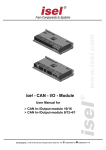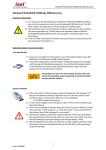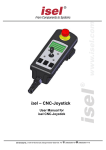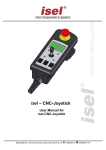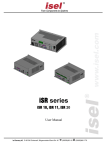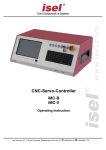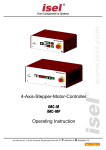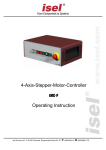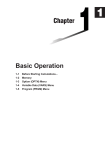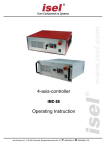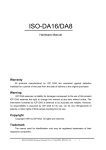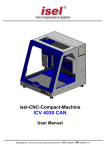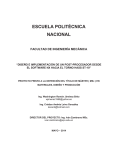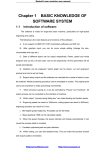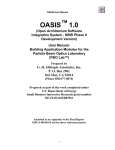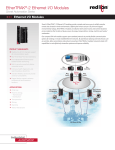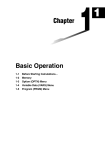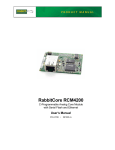Download CAN IO User Manual
Transcript
CAN I/O 16/16 CAN I/O 8/12 – 4/1 Operating Instruction isel - CAN - I/O - Modules CAN I/O 16/16 CAN I/O 8/12 - 4/1 isel Germany AG, D-36124 Eichenzell, Bürgermeister-Ebert-Str. 40 (06659)981-0 (06659)981-776 About this manual: The information, technical data and dimensions contained in this print are up-to-date when published. Any possible misprints and mistakes cannot be excluded however. We are thankful for any suggestion for improvement and indication of mistakes. Please note that the used software- and hardware descriptions of each individual company are generally subject to protection of trademarks and patent law. All rights reserved. It is not permitted to reproduce or electronically process, duplicate or spread any part of our prints in any way (print, copy etc.) without written permission of isel Germany AG. Manufacturer: isel Germany AG Bürgermeister-Ebert-Straße 40 D-36124 Eichenzell Tel.: (06659) 981-0 Fax: (06659) 981-776 Email: [email protected] http://www.isel-germany.de Part.-No.: 970321 BE004 Status: 03/2013 Contents 1 2 3 4 Introduction ......................................................................................................... 2 1.1 General function, benefit in application ........................................................ 2 1.2 Intended use................................................................................................. 3 1.3 Safety symbols ............................................................................................. 3 1.4 Safety guidelines .......................................................................................... 4 Technical specifications .................................................................................... 5 2.1 General, process - and logic power supply .................................................. 5 2.2 Module overview .......................................................................................... 7 2.3 Plug allocation .............................................................................................. 8 2.4 DIP Switches .............................................................................................. 12 2.5 Assembly, installation, connection.............................................................. 13 2.5.1 Base connection (Logic voltage and CAN bus) 13 2.5.2 Digital inputs 13 2.5.3 Digital outputs (relay outputs) 14 2.5.4 Digital electronic outputs (switching transistors) 15 2.5.5 Analog output 16 2.5.6 Analog input 18 2.5.7 Diagnosis, signalization, fault states 18 Integration into the control software (ProNC, Remote) ................................. 19 3.1 Settings in the module management .......................................................... 19 3.2 Settings within the Contro administration ................................................... 21 3.3 Version information .................................................................................... 24 3.4 Diagnosis function ...................................................................................... 25 3.5 Status information ...................................................................................... 26 Index .................................................................................................................. 27 isel - CAN - I/O – Modules: Operating Instruction 1 Introduction 1.1 General function, benefit in application The CAN-I/O-Module is an Input/output-module for peripheral automation linking intelligent modules to the CAN bus (Controller Area Network). by Such modules are: Positioning modules for numerical axes, e.g. IMD10, IMD20, IMD40 or CPC12 interface from isel Germany AG HF-Inverter for working spindles I/O-Modules for binary (analog) input/output, e.g. CAN-I/O-Modules from isel Germany AG All CAN-Modules are intelligent, that means they have at least one microprocessor with integrated on chip or separate CAN-Controller. The CAN-I/O-Modules follow the CANopen- Standard Device profile for I/O-Modules: CiA Draft Standard Proposal DS301 V4.0 und DS401 V2.0. The advantages of using I/O-Modules with CAN interface are: The binary (analog) Inputs and Outputs are available close to the process sensors (inputs) as well as to the actuators (outputs). A costly, susceptible and EMC sensitive cabling to the (central) CNC-Controller (CNC-Master, CNCControl) will be cancelled. Additional modules can be integrated and configured in a simply way: 1. Plug node to CAN-Bus 2. Set a new node address for the I/O module 3. Assign the respective software driver (DLL) to the application software (ProNC or Remote) There are extensive diagnostic- and test-possibilities because every CAN-I/OModule is intelligent. That means, that the modules are able to give status and error information to the CNC-Master (this is also the CAN Master) on demand. Page - 2 isel - CAN - I/O – Modules: Operating Instruction 1.2 Intended use The CAN-I/O module is intended to be used as a peripheral Input / Output module and therewith to connect sensors and actuators from an industrial process to this module: binary or analog sensors binary or analog actuators (Inputs) (Outputs) 1.3 Safety symbols Danger This symbol indicates dangers that cause damages for person’s health, physical injury or death. Attention This Symbol indicates important notes. Ignoring this symbol leads to damages and malfunctions of the module. Information This symbol indicates important information and notes. . Page - 3 isel - CAN - I/O – Modules: Operating Instruction 1.4 Safety guidelines The CAN-I/O-Modules 16/16 resp. 8/12-4/1 are designed due to current technical and recognized rules. Do not expose the device to high humidity or high vibrations. Admissible ambient temperature : Storage temperature : The device may only be used if it is in correct condition. Any faults have to be eliminated immediately. Neither children nor non-authorized persons are allowed to put the device into operation. The device may only be used for the intended use, i.e. I/O operations. All work on the module must be executed from authorized personal regarding electrical industry rules and accident prevention regulations. Assembly and use of operating material has to be according to the appointments of Machinery Directive 2006/42/EU resp. the Low Voltage Directive 2006/95/EU. In case of improper, incorrect use even the compliance of the respective rules and standards does not protect against physical damages and damage to property. Please take care of the instruction manual. Be sure that all users know the instructions. Ignoring the instruction manual can lead to damage, heavy physical damage or to death. +5°C bis +40°C –25°C bis +70°C Page - 4 isel - CAN - I/O – Modules: Operating Instruction 2 Technical specifications 2.1 General, process - and logic power supply box size: 85mm (B) x 180mm (H) x 28mm (T) weight: 260 g safety class: IP20 power supply 1: (logic voltage) 24VDC The logic voltage supplies the module internal logic like the CANopen microcontroller, DA and AD converters, optocouplers, relays and the CAN bus drivers. The logic voltage is feeded to the module via connector X1 from an external 24VDC power supply device. power supply 2: (process voltage) 24VDC The process voltage supplies sensors and actuators that are connected to the CAN-I/O module: binary process sensors like switches or inductive sensors binary process actuators like Ohm or inductive loads The process voltage is feeded to the module via connector X4 (+24V) resp. connector X6 (GND) from an external 24VDC power supply device. power consumption 1: (from / over logic voltage) 160mA power consumption 2: (from / over process voltage) Power consumption (from / over process voltage) depends from the external loads, e.g. especially from the binary process actuators connected to the module. Dimensioning the 24VDC power supply device for process voltage with a sufficient value is very important. The customer is responsible to do this dimensioning correctly. ambient temperature: 5°C bis +40°C storage temperature: -25°C bis +70°C relative humidity: max. 95% Page - 5 isel - CAN - I/O – Modules: Operating Instruction CAN – I/O - 16/16 digital inputs: 16 In1.1 to In1.8 and In2.1 to In2.8 using optocouplers (input current about 8mA) digital outputs: 16 Out1.1 to Out1.8 and Out2.1 to Out2.8 8 relay outputs Out1.1 to Out1.8, Imax < 5A 8 electronic outputs (switching transistors) Out2.1 to Out2.8, Imax < 350mA, switching delay about 100µs, thermic protection, short-circuit protection catch diode for digital outputs Each inductive load plugged to digital outputs requires a separate external catch diode. analog output: 1 0V – 10V over 8 Bit D/A converter (if the analog output is used the eight electronic digital outputs Out2.1 to Out2.8 can not be used for binary output) fuse: 630 mA / 250V fast CAN – I/O - 8/12 - 4/1 digital inputs: 8 In1.1 to In1.8 using optocouplers (input current about 8mA) digital outputs: 12 Out1.1 to Out1.8 and Out2.1 to Out2.4 4 relays outputs Out2.1 to Out2.4, Imax < 5A 8 electronic outputs (switching transistors) Out1.1 to Out1.8, Imax < 350mA, switching delay about 100µs, thermic protection, short-circuit protection catch diode for digital outputs Each inductive load plugged to digital outputs requires a separate external catch diode. analog output: 1 0V – 10V over 8Bit D/A transformer analog inputs: 4 Ana In1 bis Ana In4, 0V – 10V, 16 Bit resolution fuse: 630mA / 250V fast Page - 6 isel - CAN - I/O – Modules: Operating Instruction 2.2 Module overview CAN-IO-16/16 Process voltage: GND 24VDC Logic voltage 24VDC Logic voltage CAN-IO-8/12- 4/1 Process voltage: GND Page - 7 isel - CAN - I/O – Modules: Operating Instruction 2.3 Plug allocation Supply voltage (Logic voltage) Phoenix Mini Combicon 2 pins modul connector CAN-IO 16/16 X1 CAN-IO 8/12-4/1 X1 pin 1 2 1 2 signal GND +24V GND +24V description supply voltage GND supply voltage +24V supply voltage GND supply voltage +24V CAN In, CAN Out RJ45 connector modul connector CAN- IO 16/16 X2 CAN In X3 CAN Out CAN-IO 8/12-4/1 X2 CAN In X3 CAN Out pin 1 2 3 4 5 6 7 8 1 2 3 4 5 6 7 8 signal n.c. n.c. n.c. CAN_H CAN_L CAN_GND n.c. n.c. n.c. n.c. n.c. CAN_H CAN_L CAN_GND n.c. n.c. Page - 8 description not connected not connected not connected signal CAN high signal CAN low GND not connected not connected not connected not connected not connected signal CAN high Signal CAN low GND not connected not connected isel - CAN - I/O – Modules: Operating Instruction Input ports Phoenix Mini Combicon 8 x 2 pins module connector CAN- IO 16/16 X4 In 1 and X5 In 2 CAN-IO 8/12-4/1 X4 In 1 pin bottom 1 2 3 4 5 6 7 8 pin top 9 10 11 12 13 14 15 16 pin bottom 1 2 3 4 5 6 7 8 pin top 9 10 11 12 13 14 15 16 Page - 9 signal +24V +24V +24V +24V +24V +24V +24V +24V signal In 1 In 2 In 3 In 4 In 5 In 6 In 7 In 8 signal +24V +24V +24V +24V +24V +24V +24V +24V signal In 1 In 2 In 3 In 4 In 5 In 6 In 7 In 8 description description bit 0 bit 1 bit 2 bit 3 bit 4 bit 5 bit 6 bit 7 description description bit 0 bit 1 bit 2 bit 3 bit 4 bit 5 bit 6 bit 7 isel - CAN - I/O – Modules: Operating Instruction Output ports Phoenix Mini Combicon 8 x 2pol. module CAN- IO 16/16 CAN-IO 8/12-4/1 connector X6 Out 1 X7 Out 2 X6 Out 1 X7 Out 2 pin bottom 1 2 3 4 5 6 7 8 pin top 9 10 11 12 13 14 15 16 pin bottom 1 2 3 4 5 6 7 8 pin top 9 10 11 12 13 14 15 16 Page - 10 signal GND GND GND GND GND GND GND GND signal Out 1 Out 2 Out 3 Out 4 Out 5 Out 6 Out 7 Out 8 description description bit 0 bit 1 bit 2 bit 3 bit 4 bit 5 bit 6 bit 7 GND GND GND GND GND GND GND GND Out 1 Out 2 Out 3 Out 4 Out 5 Out 6 Out 7 Out 8 bit 0 bit 1 bit 2 bit 3 bit 4 (not on X7) bit 5 (not on X7) bit 6 (not on X7) bit 7 (not on X7) isel - CAN - I/O – Modules: Operating Instruction Analog output Phoenix Mini Combicon 2 pins module CAN-IO 16/16 CAN-IO 8/12-4/1 connector pin 1 X8 AnaOut 2 1 X8 AnaOut 2 signal analog Out GND analog Out analog Out GND analog Out description reference for analog output analog output (0 – 10V) reference for analog output analog output (0 – 10V) Analog inputs Phoenix Mini Combicon 2 pins module connector CAN- IO 16/16 CAN-IO 8/12-4/1 pin bottom signal - X9 AnaIn - pin bottom 1 2 3 4 pin top 5 6 7 8 description - signal GND GND GND GND description reference for analog input 1 reference for analog input 2 reference for analog input 3 reference for analog input 4 Analog In 1 Analog In 2 Analog In 3 Analog In 4 analog input 1 analog input 2 analog input 3 analog input 4 Page - 11 isel - CAN - I/O – Modules: Operating Instruction 2.4 DIP Switches The node address of a CAN module is used to clearly identify the device on the CAN bus. We submit the following assignment of the modules node address: Module 1. positioning module 2. positioning module 3. positioning module additional positioning module 4. I/O-module (firstt) 5. I/O-module (second) additional I/O-modules 6. HF- converter additional HF-converter Node address Node address 1 Node address 2 Node address 3 Node address 4-9 Node address 16 Node address 17 Node address 18 and 19 Node address 10 Node address 11,12 or 13 CAN Node address (S1 – S5) The switches S1 – S5 are used to set the CAN node address. Possible values are 1 to 31. Node address 16 17 … 31 S1 off on S2 off off S3 off off S4 off off S5 on on on on on on on Baud rate (S6 – S7) The switches S6 and S7 are used to set the baud rate. Following values are possible: Baud rate 1 MBit/s 500 kBit/s 125 kBit/s 20 kBit/s S6 off on off on S7 off off on on Terminating resistor (S8) Switch S8 is used to switch a CAN bus termination resistor on or off. If the switch is on a 120 Ω resistor is enabled. Page - 12 isel - CAN - I/O – Modules: Operating Instruction 2.5 Assembly, installation, connection Be sure that the jumper settings are correct before you build in the CAN-I/O module into a Control cabinet or another device (refer to chapter 2.4). 2.5.1 Base connection (Logic voltage and CAN bus) If you have configured the DIP switches the module can be built in to the intended mounting place. Now the 24V-power supply (logic voltage) must be connected with X1 (see connection assignment). Also the CAN- bus interface connection must be plugged in (CAN In must be connected) If the CAN-I/O-module is the last device in the CAN-topology the DIP-switch 8 must be set to “on” to enable the terminating resistor. 2.5.2 Digital inputs The digital inputs of the CAN-I/O-modules are realized using 24V-DC process voltage. They can be connected to process sensors as follows: The reference potential (+24VDC, GND) for the external sensor (in the principle drawing a simple switch) is the process voltage. The input load is about 8mA. Page - 13 isel - CAN - I/O – Modules: Operating Instruction 2.5.3 Digital outputs (relay outputs) The digital relay outputs of the CAN-I/O-modules switch 24V-DC process voltage. Integrate the outputs as follows: The reference potential (+24VDC, GND) for the external actuator (in the principle drawing a simple resistor) is the process voltage. The relay outputs Out1.1 to Out1.8 at CAN-I/O-Module CAN-IO 16/16 Out2.1 to Out2.4 at CAN-I/O-Module CAN-IO 8/12-4/1 = port1 (X6) = port2 (X7) can be rated with 5A for each output. Driving inductive loads on digital outputs (for example relays) put parallel to every load (relay) a catch diode (anode to GND). Page - 14 isel - CAN - I/O – Modules: Operating Instruction 2.5.4 Digital electronic outputs (switching transistors) The digital electronic outputs (switching transistors, P channel, 24V switching) of the CAN-I/O-modules switch 24 VDC process voltage. Integrate the outputs as follows: The reference potential (+24VDC, GND) for the external actuator (in the principle drawing a simple resistor) is the process voltage. The digital electronic outputs Out2.1 to Out2.8 at CAN-I/O-Module CAN-IO 16/16 Out1.1 to Out1.8 at CAN-I/O-Module CAN-IO 8/12-4/1 can be loaded with max. 350mA on each output. = port2 (X7) = port1 (X6) IMPORTANT when using the CAN-I/O-Module CAN-IO 16/16, here obtains for digital electronic outputs Out2.1 bis Out2.8 = Port2 (X7): If the integrated D/A converter is used for analog output then port2 is reserved. That means port2 is not longer available for digital outputs. To prevent confusions you can deactivate port2 by removing Jumper1 (refer the next chapter Analog output). Through this the port2 LEDs are also deactivated. Driving inductive loads on digital outputs (for example relays) put parallel to every load (relay) a catch diode (anode to GND). Page - 15 isel - CAN - I/O – Modules: Operating Instruction 2.5.5 Analog output You can use this output for controlling an external device with 0 to 10V interface / input (e.g. the target velocity for HF converter). If the analog output ist used, port2 is no longer available for digital outputs. Output current not more than 15mA! CAN-I/O 16/16 Jumper settings Jumper 1 plugged: - if the analog output is in use the LEDs from output Port A2 signalize the binary analog output value. Delivery state: Jumper 2 (4 pieces) not plugged. Galvanic separation the 24DCV process voltage from 24VDC logic voltage is guaranteed. If you plug the jumpers 2 then there is no galvanic separation between 24VDC process voltage and 24VDC logic voltage! This may be effects damages on the CAN-I/O-Module. Page - 16 isel - CAN - I/O – Modules: Operating Instruction CAN-I/O 8/12 - 4/1 Jumper settings Delivery state: Jumper 1 (4 pieces) Jumper 1 is not plugged. Galvanic separation the 24VDC process voltage from 24VDC logic voltage is guaranteed. If you plug the jumper 1 then there is no galvanic separation between 24VDC process voltage and 24VDC logic voltage! This may be effects damages on the CAN-I/O-Module Page - 17 isel - CAN - I/O – Modules: Operating Instruction 2.5.6 Analog input The module CAN-I/O-8/12-4/1 has 4 analog Inputs with an input voltage range from 0V to10V and a resolution of 16 Bit. On these inputs you can directly connect e.g. sensors. These inputs have an input impedance of 2kΩ and provides an internal RC filter. 2.5.7 Diagnosis, signalization, fault states Diagnosis of the CAN-I/O modules is possible by observing the status LED. CAN-IO-16/16 Status-LED CAN-IO-8/12- 4/1 Status-LED This LED signals 4 different states: LED duty cycle 0%, off 10% 50% 90% State Error: CAN I/O module is not in operational state, logic voltage is not available or the internal power supply (DC/DC: 24 VDC to 5,0 V) is damaged No error normal operation Uncritical error or warning Critical error (NMT error, output error) Page - 18 isel - CAN - I/O – Modules: Operating Instruction 3 Integration into the control software (ProNC, Remote) 3.1 Settings in the module management At first the Interface-DLL which opens the connection between ProNC/Remote and CAN-IO-Device must be set-up. If not already available, copy the files IoCan.DLL and IoCan.INI into a new sub-directory of the CNCworkbench - directory. Our suggestion for the new directory: {ProgramPath}\CNCWorkbench\Control\Can\ After the files are copied the application must get to know the new IO-deviceTherefore start ProNC/Remote and open the Setup-dialog for the control with the help of the command "Setup – Control…". The following dialog will be appear: Page - 19 isel - CAN - I/O – Modules: Operating Instruction Follow the commands to get the USB-IO device into the modul management: Choose in the tree view the IO-Modul which is not in use and name it e.g”CAN-IO16/16 Node address is 16" or only "CAN IO". Click on ">>" next to the Edit field "Modul DLL". Choose the "IoCan.DLL" in the "\CNCWorkbench\Control\Can" directory. The Edit field "Modul initialisation file" shows automatically the “CNCWorkbench\Control\Can\IoCan.INI" file. You don’t need to rename the file. Click on button (in case nothing will happen, choose another IOModul from the tree view and after that choose the IO-Modul for the CAN-IO). Click on to open the Setup dialog. In this dialog you can set different settings for the module. The most important setting are the node address of the module. The default value for the address is 16. Furthermore you can set initialization values for digital and analog output ports. If you start the software (ProNC / Remote) these values will be set. Page - 20 isel - CAN - I/O – Modules: Operating Instruction 3.2 Settings within the Contro administration To get access to the IO-module within the Control administration one setting in the top level must be changed. Open the "Extended settings-IO" - Dialog as follows. Highlight in the tree structure "IO modules". Click on right side. You can see the following dialog: on the The IO-module " CAN-IO-16/16 Node address is 16" needs a logical Input / Output port number to access the Input / Output-functions from the CNC control software ProNC resp. Remote. Page - 21 isel - CAN - I/O – Modules: Operating Instruction Mind the following notes: Highlight a free logical port, for example: Input port 1 Choose in the button band the button "▼Assigned IO module" by mouse click, then the element "[1] CAN IO 16/16 Node address is 16": Choose in the button band the button “▼ Local port in module" by mouse click, then the element “Local Port 1”: Click on “OK” to close the dialog Now you must do the described steps for all logical output ports, analog output and analog input. You find these entries by scrolling down in the list field. Close the dialog “Control modules and settings” over the button “Close & Initialize” to reinitialize the new modules. Page - 22 isel - CAN - I/O – Modules: Operating Instruction The following lines show the use of local input ports, output ports, analog output and analog input of the different modules. CAN- IO- 16/16 Local input ports: Local output ports: Port 1 and Port 2 Port 1 and Port 2 Local analog output: Port 1 (alternatively with the local output port Port 2) If the analog output is used, Port 2 (X7) is no longer available for digital outputs. You must clear the entry for this port in the list. CAN- IO- 8/12- 4/1 Local input ports: Local output ports: Port 1 Port 1 and Port 2 Local analog output: Local analog inputs: Port 1 Port 1 - Port 4 At the local output port 2 you can only use the outputs 1-4: A2.1 = Out 2.1 A2.2 = Out 2.2 A2.3 = Out 2.3 A2.4 = Out 2.4 Page - 23 isel - CAN - I/O – Modules: Operating Instruction 3.3 Version information Inside the module management you can show version information of the used module DLL and the connected device type by pressing the button Page - 24 . isel - CAN - I/O – Modules: Operating Instruction 3.4 Diagnosis function The button allows you to access input / output functions of the connected CAN-I/O-module. In this dialog you can e.g. switch outputs separately or you can check the state of inputs. Page - 25 isel - CAN - I/O – Modules: Operating Instruction 3.5 Status information Using the button you can check whether the process voltage is connected to the CAN I/O module. If there is no process voltage connected to the CAN I/O module you can not measure 24VDC potential between the load connectors X4 (24VDC) and X6 (GND). Page - 26 isel - CAN - I/O – Modules: Operating Instruction 4 Index A M actuators...................................................................... 3 ambient temperature ................................................... 4 module management ................................................. 24 N C node address.......................................................... 2, 20 CAN bus ....................................................................... 2 CANopen...................................................................... 2 catch diode ............................................................ 6, 14 CNC-Controller ............................................................. 2 P process voltage ...................................................... 5, 26 G galvanic separation .............................................. 16, 17 R resolution..................................................................... 6 I intended use ................................................................ 4 IoCan.DLL ................................................................... 20 J S sensors......................................................................... 3 short-circuit protection ................................................ 6 Status-LED ................................................................. 18 Storage temperature .................................................... 4 switching delay............................................................. 6 Jumper 1.............................................................. 16, 17 Jumper 2.................................................................... 16 T L logic voltage ................................................................. 5 terminating resistor .................................................... 13 termination resistor.................................................... 12 thermic protection ....................................................... 6 Page - 27





























